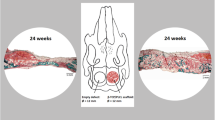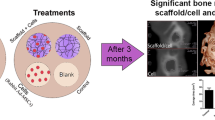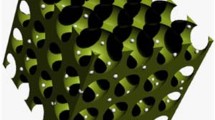Abstract
Objective: To evaluate a new biodegradable copolymer calcium sulfate/poly amino acid (CS/PAA) as a graft substitute for the repair of the surgically created cancellous bone defects in rabbits and its biological properties in vivo.
Materials and Methods: Cancellous bone defects were created by drilling holes in the unilateral lateral aspect of the femoral condyle of New Zealand white rabbits. Three groups were assigned: Group A rabbits were grafted with 80% CS/PAA and group B rabbits were grafted with 95% CS/PAA as two treatment groups; group C was sham-operation control group. To study the osteogenic capability in vivo, specimens were harvested at 4, 8, 12, and 16 weeks after implantation and were evaluated by gross assessment, X-ray, histological examination, and histomorphometry. In order to identify the molecular mechanism of bone defect repair, the expression of bone morphogenetic protein-2 (BMP-2) and vascular endothelial growth factor (VEGF) was detected using Western blot at 4 weeks.
Results: Group A and group B showed more vigorous and rapid repair leading to regeneration of cancellous bone than sham-operation control group on gross observation, radiology, and histomorphometry. There was no significant difference between groups A and B. Morphological observation and histological examination showed that the copolymers degraded in sync with the new bone formation process. The expression of BMP-2 and VEGF in implantation groups was higher than that in control group by western blot.
Conclusion: These findings demonstrated that the novel biodegradable copolymers can repair large areas of cancellous bone defects. With its controllable degradation rate, it suggests that CS/PAA may be a series of useful therapeutic substitute for bone defects.
Similar content being viewed by others
References
Akita S, Fukui M, Nakagawa H, Fujii T, Akino K. Cranial bone defect healing is accelerated by mesenchymal stem cells induced by coadministration of bone morphogenetic protein-2 and basic fibroblast growth factor. Wound Repair Regen 2004;12:252–9.
Muscolo DL, Ayerza MA, Aponte-Tinao LA. Massive allograft use in orthopedic oncology. Orthop Clin North Am 2006;37:65–74.
Holzwarth JM, Ma PX. Biomimetic nanofibrous scaffolds for bone tissue engineering. Biomaterials 2011;32:9622–9.
Lee SH, Shin H. Matrices and scaffolds for delivery of bioactive molecules in bone and cartilage tissue engineering. Adv Drug Deliv Rev 2007;59:339–59.
Matsushita N, Terai H, Okada T, Nozaki K, Inoue H Miyamoto S, et al. Accelerated repair of a bone defect with a synthetic biodegradable bone-inducing implant. J Orthop Sci 2006;11:505–11.
Gorna K, Gogolewski S. Novel biodegradable polyurethanes for medical applications. In: Agrawal CM, Parr JE, Lin ST, editors. Synthetic Bioresorbable Polymers for Implants, ASTM STP 1396. West Conshohocken, PA: ASTM; 2000. p. 39–57.
Gorna K, Gogolewski S. In vitro degradation of novel medical biodegradable aliphatic polyurethanes based on epsilon-caprolactone and Pluronics (R) with various hydrophilicities. Polym Degrad Stab 2002;75:113–22.
Ip WY, Gogolewski S. Clinical application of resorbable polymers in guided bone regeneration. Macromol Symp 2007;253:139–46.
Winn SR, Hu Y, Sfeir C, Hollinger JO. Gene therapy approaches for modulating bone regeneration. Adv Drug Deliv Rev 2000;42:121–38.
Vacanti CA, Bonassar LJ. An overview of tissue engineered bone. Clin Orthop Relat Res 1999;367(Suppl): S375–81.
Fei Z, Hu Y, Wu D, Wu H, Lu R, Bai J, et al. Preparation and property of a novel bone graft composite consisting of rhBMP-2 loaded PLGA microspheres and calcium phosphate cement. J Mater Sci Mater Med 2008;19:1109–16.
Barrera DA, Zylstra E, Lansbury PT, Langer R. Synthesis and RGD peptide modification of a new biodegradable copolymer: Poly(lactic acid-colysine). J Am Chem Soc 1993;115:11010–1.
Gitelis S, Piasecki P, Turner T, Haqqard W, Charters J, Urban R. Use of a calcium sulfate-based bone graft substitute for benign bone lesions. Orthopedics 2001;24:162–6.
Kelly CM, Wilkins RM. Treatment of benign bone lesions with an injectable calcium sulfate-based bone graft substitute. Orthopedics 2004;27(1 suppl):131–5.
Kelly CM, Wilkins RM, Gitelis S, Hartjen C, Watson JT, Kim PT. The use of a surgical grade calcium sulfate as a bone graft substitute: Results of a multicenter trial. Clin Orthop Relat Res 2001;382:42–50.
Parfitt AM, Drezner MK, Gliorieux FH, Kanis JA, Malluche H, Meunier PJ, et al. Bone histomorphometry: Standardization of nomenclature, symbols and units. J Bone Miner Res 1987;2:595–610.
Russell JL, Block JE. Clinical utility of demineralized bone matrix for osseous defects, arthrodesis, and reconstruction: Impact of processing techniques and study methodology. Orthopedics 1999;22:524–33.
Yoshikawa T, Ohgushi H. Autogenous cultured bone graft–bone reconstruction using tissue engineering approach. Ann Chir Gynaecol 1999;88:186–92.
Giannoudis PV, Faour O, Goff T, Kanakaris N, Dimitriou R. Masquelet technique for the treatment of bone defects: Tips-tricks and future directions. Injury 2011;42:591–8.
Constantino PD, Friedman CD. Synthetic bone graft substitutes. Otolaryngol Clin North Am 1994;27:1037–74.
Green D, Walsh D, Mann S, Oreffo RO. The potential of biomimesis in bone tissue engineering: Lessons from the design and synthesis of invertebrate skeletons. Bone 2002;30:810–5.
Burg KJ, Porter S, Kellam JF. Biomaterial developments for bone tissue engineering. Biomaterials 2000;21:2347–59.
Walsh WR, Morberg P, Yu Y, Yang JL, Haggard W, Sheat PC, et al. Response of a calcium sulphate bone graft substitute in a confined cancellous defect. Clin Orthop Relat Res 2003;406:228–36.
Pecora G, Andreana S, Margarone JE 3rd, Covani U, Sottosanti JS. Bone regeneration with a calcium sulfate barrier. Oral Surg Oral Med Oral Pathol Oral Radiol Endod 1997;84:424–9.
Doadrio JC, Arcos D, Cabanas MV, Vallet-Regi M. Calcium sulphate-based cements containing cephalexin. Biomaterials 2004;25:2629–35.
D’Ayala GG, De Rosa A, Laurienzo P, Malinconico M. Development of a new calcium sulphate-based composite using alginate and chemically modified chitosan for bone regeneration. J Biomed Mater Res A 2007;81:811–20.
Schroeder JE, Mosheiff R. Tissue engineering approaches for bone repair: Concepts and evidence. Injury 2011;42:609–13.
Chang KY, Cheng LW, Ho GH, Huang YP, Lee YD. Fabrication and characterization of poly(γ-glutamicacid)-graft-chondroitin sulfate/polycaprolactone porous scaffolds for cartilage tissue engineering. Acta Biomater 2009;5:1937–47.
Lee CT, Huang CP, Lee YD. Biomimetic porous scaffolds made from poly(L-lactide)-g-chondroitin sulfate blend with poly(L-lactide) for cartilage tissue engineering. Biomacromolecules 2006;7:2200–9.
De Biase P, Campanacci DA, Beltrami G, Scoccianti G, Ciampalini L, Pecchioli O, et al. Scaffolds combined with stem cells and growth factors in healing of pseudotumoral lesions of bone. Int J Immunopathol Pharmacol 2011;24(1 Suppl 2):11–5.
Yuan H, Fernandes H, Habibovic P, de Boer J, Barradas AM, de Ruiter A, et al. Osteoinductive ceramics as a synthetic alternative to autologous bone grafting. Proc Natl Acad Sci U S A 2010;107:13614–9.
Athanasiou VT, Papachristou DJ, Panagopoulos A, Saridis A, Scopa CD, Megas P. Histological comparison of autograft, allograft-DBM, xenograft, and synthetic grafts in a trabecular bone defect: An experimental study in rabbits. Med Sci Monit 2010;16: BR24–31.
Xiao C, Zhou H, Ge S, Tang T, Hou H, Luo M, et al. Repair of orbital wall defects using biocoral scaffolds combined with bone marrow stem cells enhanced by human bone morphogenetic protein-2 in a canine model. Int J Mol Med 2010;26:517–25.
Miyagi Y, Chiu LL, Cimini M, Weisel RD, Radisic M, Li RK. Biodegradable collagen patch with covalently immobilized VEGF for myocardial repair. Biomaterials 2011;32:1280–90.
Matsumoto Y, Okada Y, Fukushi J, Kamura S, Fujiwara T, Lida K, et al. Role of the VEGF-Flt-1-FAK pathway in the pathogenesis of osteoclastic bone destruction of giant cell tumors of bone. J Orthop Surg Res 2010;5:85.
Author information
Authors and Affiliations
Corresponding author
Rights and permissions
About this article
Cite this article
Yang, X., Li, Y., Huang, Q. et al. Evaluation of a biodegradable graft substitute in rabbit bone defect model. IJOO 46, 266–273 (2012). https://doi.org/10.4103/0019-5413.96371
Published:
Issue Date:
DOI: https://doi.org/10.4103/0019-5413.96371




